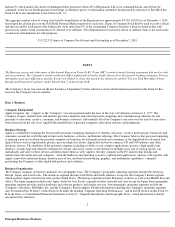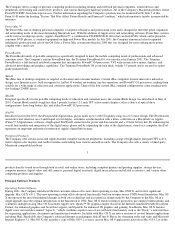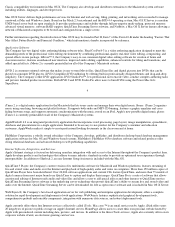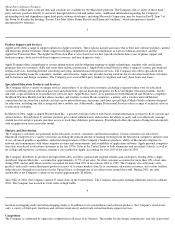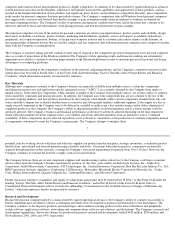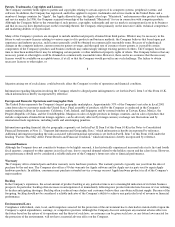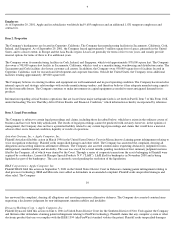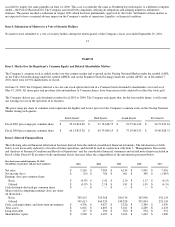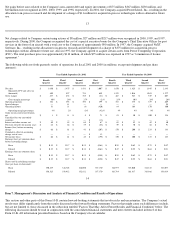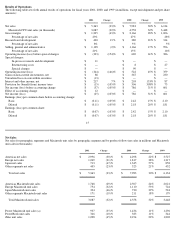Apple 2001 Annual Report Download - page 4
Download and view the complete annual report
Please find page 4 of the 2001 Apple annual report below. You can navigate through the pages in the report by either clicking on the pages listed below, or by using the keyword search tool below to find specific information within the annual report.
The Company offers a range of personal computing products including desktop and notebook personal computers, related devices and
peripherals, networking and connectivity products, and various third-
party hardware products. All of the Company's Macintosh products utilize
PowerPC® RISC-based microprocessors. Further information regarding the Company's products may be found in Part II, Item 7 of this
Form 10-K under the heading "Factors That May Affect Future Results and Financial Condition," which information is hereby incorporated by
reference.
Power Mac
™
The Power Mac line of desktop personal computers is targeted at business and professional users and is designed to meet the speed, expansion
and networking needs of the most demanding Macintosh user. With the addition of Apple server and networking software, Power Mac systems
can be used as workgroup servers. Apple's SuperDrive™, a combination CD-RW/DVD-R drive that can burn DVDs which can be played in
consumer DVD players, is standard equipment on high-end Power Mac models. In July 2001, the Company announced it had suspended
indefinitely production and sale of the G4 Cube, a Power Mac system introduced in 2000 that was designed for users seeking more power
coupled with a small size.
PowerBook
®
The PowerBook family of portable computers is specifically designed to meet the mobile computing needs of professionals and advanced
consumer users. The Company's current PowerBook line, the Titanium PowerBook G4, was introduced in January 2001. The Titanium
PowerBook is a full-featured notebook computer that incorporates PowerPC G4 processors, TFT wide-screen active-matrix displays, and
advanced networking and graphics capabilities. The Titanium PowerBook G4 is one inch thick, weighs 5.3 pounds and is encased in a pure-
grade titanium body.
iMac®
The iMac line of desktop computers is targeted at education and consumer markets. Current iMac computers feature innovative industrial
design, easy Internet access, built-in support for AirPort ® wireless networking, fan-less operation, and PowerPC G3 processors, making them
suitable for a wide range of education and consumer applications. Three of the four current iMac standard configurations come standard with
slot-loading CD-RW drives.
iBook®
Designed specifically for the portable computing needs of education and consumer users, the current iBook design was introduced in May of
2001. Current iBook models weigh less than 5 pounds, feature 12.1 inch TFT active-matrix displays, offer a choice of optical drive
configurations, have long battery life, and utilize PowerPC G3 processors.
iPod™
Introduced in October 2001, the iPod portable digital music player holds up to 1,000 CD-quality songs in a 6.5 ounce design. The iPod features
an intuitive user interface on a 2-inch liquid crystal display, automatic synchronization with a music collection on a Macintosh via Apple's
iTunes™ 2 digital music software, a high-speed FireWire® connection for power and data transfer and a 10 hour battery life. By enhancing the
overall functionality and integration of the digital music player and by expanding the value of the digital music stored on a computer, the iPod
represents an important and natural extension of Apple's digital hub strategy.
Peripheral Products
The Company sells certain associated Apple-branded computer hardware peripherals, including a range of high quality flat panel TFT active-
matrix digital color displays and AirPort wireless networking base stations and add-in cards. The Company also sells a variety of third-party
Macintosh-compatible hardware
3
products directly to end users through both its retail and online stores, including computer printers and printing supplies, storage devices,
computer memory, digital video and still cameras, personal digital assistants, digital music players and related accessories, and various other
computing products and supplies.
Principal Software Products
Operating System Software
During 2001, the Company introduced the first customer release of its new client operating system, Mac OS® X, and its first significant
upgrade, Mac OS X v10.1. This new operating system offers advanced functionality built on an open-source UNIX-based foundation. Mac OS
X incorporates the most fundamental changes in both core technology and user interface design made by the Company to the Mac OS in a
single upgrade since the original introduction of the Macintosh in 1984. Mac OS X features memory protection, pre-emptive multi-
tasking, and
symmetric multiprocessing. Mac OS X includes Apple's new Quartz™ 2D graphics engine (based on the Internet-standard Portable Document
Format) for enhanced graphics and broad font support, and OpenGL for enhanced 3D graphics and gaming. In addition, Mac OS X features
Apple's new user interface named "Aqua ® ," which combines superior ease-of-use with new functionality such as the "Dock," a new interface
for organizing applications, documents and miniaturized windows. Included with Mac OS X are native versions of several Internet applications
including Mail, Sherlock®, the Company's advanced Internet search engine, QuickTime ® Player for streaming audio and video and Microsoft
Internet Explorer 5.1. Mac OS X also includes a copy of Mac OS 9.2 so users can run Mac OS 9 applications natively in Mac OS 9.2 or in the



